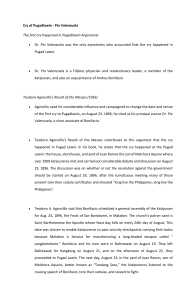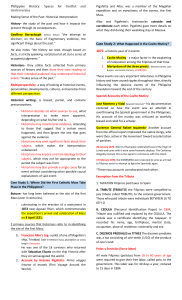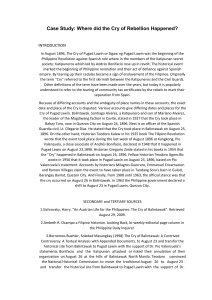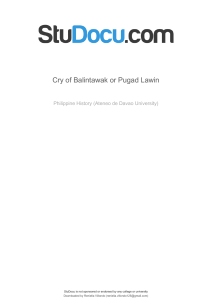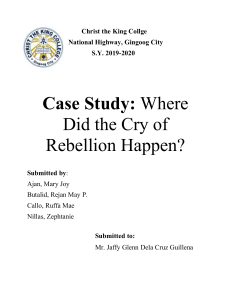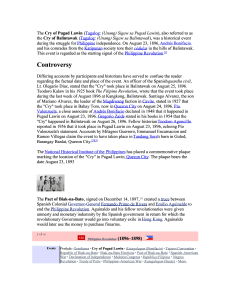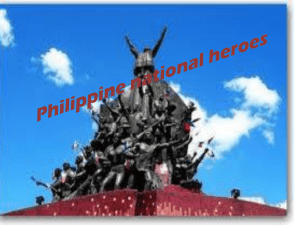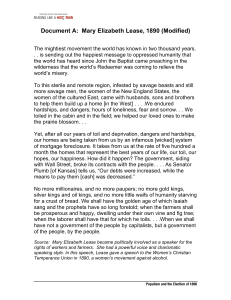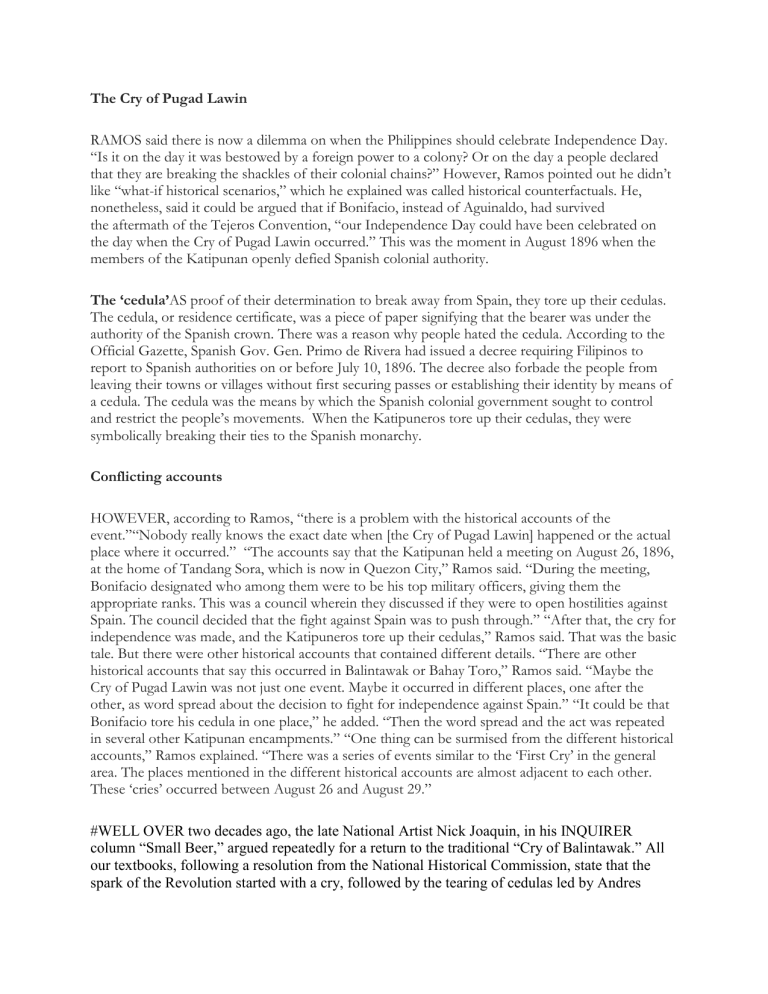
The Cry of Pugad Lawin RAMOS said there is now a dilemma on when the Philippines should celebrate Independence Day. “Is it on the day it was bestowed by a foreign power to a colony? Or on the day a people declared that they are breaking the shackles of their colonial chains?” However, Ramos pointed out he didn’t like “what-if historical scenarios,” which he explained was called historical counterfactuals. He, nonetheless, said it could be argued that if Bonifacio, instead of Aguinaldo, had survived the aftermath of the Tejeros Convention, “our Independence Day could have been celebrated on the day when the Cry of Pugad Lawin occurred.” This was the moment in August 1896 when the members of the Katipunan openly defied Spanish colonial authority. The ‘cedula’AS proof of their determination to break away from Spain, they tore up their cedulas. The cedula, or residence certificate, was a piece of paper signifying that the bearer was under the authority of the Spanish crown. There was a reason why people hated the cedula. According to the Official Gazette, Spanish Gov. Gen. Primo de Rivera had issued a decree requiring Filipinos to report to Spanish authorities on or before July 10, 1896. The decree also forbade the people from leaving their towns or villages without first securing passes or establishing their identity by means of a cedula. The cedula was the means by which the Spanish colonial government sought to control and restrict the people’s movements. When the Katipuneros tore up their cedulas, they were symbolically breaking their ties to the Spanish monarchy. Conflicting accounts HOWEVER, according to Ramos, “there is a problem with the historical accounts of the event.”“Nobody really knows the exact date when [the Cry of Pugad Lawin] happened or the actual place where it occurred.” “The accounts say that the Katipunan held a meeting on August 26, 1896, at the home of Tandang Sora, which is now in Quezon City,” Ramos said. “During the meeting, Bonifacio designated who among them were to be his top military officers, giving them the appropriate ranks. This was a council wherein they discussed if they were to open hostilities against Spain. The council decided that the fight against Spain was to push through.” “After that, the cry for independence was made, and the Katipuneros tore up their cedulas,” Ramos said. That was the basic tale. But there were other historical accounts that contained different details. “There are other historical accounts that say this occurred in Balintawak or Bahay Toro,” Ramos said. “Maybe the Cry of Pugad Lawin was not just one event. Maybe it occurred in different places, one after the other, as word spread about the decision to fight for independence against Spain.” “It could be that Bonifacio tore his cedula in one place,” he added. “Then the word spread and the act was repeated in several other Katipunan encampments.” “One thing can be surmised from the different historical accounts,” Ramos explained. “There was a series of events similar to the ‘First Cry’ in the general area. The places mentioned in the different historical accounts are almost adjacent to each other. These ‘cries’ occurred between August 26 and August 29.” #WELL OVER two decades ago, the late National Artist Nick Joaquin, in his INQUIRER column “Small Beer,” argued repeatedly for a return to the traditional “Cry of Balintawak.” All our textbooks, following a resolution from the National Historical Commission, state that the spark of the Revolution started with a cry, followed by the tearing of cedulas led by Andres Bonifacio in Pugad Lawin, Quezon City. The issue is not just historiographical but political. If the National Historical Commission, upon review of the facts, reverses its earlier resolution and moves the site of the “Cry” back to Balintawak then history will be moved from Quezon City to Caloocan. Mayor Herbert Bautista’s loss will be Mayor Recom Echiverri’s gain. Re-opening the issue looks simple because people think it’s just like tossing a coin to decide between Balintawak or Pugad Lawin. If you bring two to three historians together you would not get a consensus. To the above options, you must add other contenders to the historical site: Kangkong, Bahay Toro, Pasong Tamo, Banlat and God knows where else, depending on the primary source being cited. If you think location is the only issue, look again. The date declared by the National Historical Commission as the start of the Philippine Revolution—Aug. 23, 1896—is but one date proposed, the others being Aug. 20, 24, 25 and 26, 1896. And, if I remember from a historical forum in UP, one scholar even insisted on a wildcard date of Sept. 5, 1896! All these debates on dates and places, which may seem trivial to the general public, is the lifeblood of historians. Teodoro A. Agoncillo said that Bonifacio scheduled a general assembly of the Katipunan for Aug. 24, 1896, the Feast of San Bartolome, in Malabon. This date was chosen to enable Katipuneros to pass security checkpoints carrying their bolos because Malabon is famous for manufacturing a long bladed weapon called “ sangbartolome.” Bonifacio and his men were in Balintawak on August 19. They left Balintawak for Kangkong on August 21, and on the afternoon of August 22 they proceeded to Pugad Lawin. The next day, August 23, in the yard of Juan Ramos, son of Melchora Aquino, better known as “Tandang Sora,” the Katipuneros listened to the rousing speech of Bonifacio, tore their cedulas, and vowed to fight. Teodoro Agoncillo convinced the National Historical Commission to move the traditional Aug. 26 date to Aug. 23 and transfer the historical site from Balintawak to Pugad Lawin. If Agoncillo’s personality wasn’t enough for the Commission, he cited as his principal source Dr. Pio Valenzuela, a close associate of Bonifacio. I wonder if other members of the commission bothered to remind Agoncillo that Valenzuela may have been in Bonifacio’s inner circle, but may be unreliable as a primary source. In Wenceslao Emilio’s fivevolume compilation of historical documents, Archivo del Bibliofilo Filipino, Valenzuela’s signed testimony before Spanish interrogators dated September 1896 stated that the Cry of Balintawak was held in Balintawak on Aug. 26, 1896. Years later, in his memoirs published in English after World War II, Valenzuela stated that the Cry was actually held in Pugad Lawin on Aug. 23, 1896. Agoncillo explained that the September 1896 account was extracted from Valenzuela under duress and couldn’t be trusted. Balintawak was the place determined by tradition and many eyewitness accounts, including Guillermo Masangkay who, in an interview in the Sunday Tribune in 1932, declared the place as Balintawak and the date Aug. 26, 1896. Spanish Lt. Olegario Diaz in 1896 pinpointed the place as Balintawak but placed the date on Aug. 24, 1896. Depending on your source, the dates and places do not seem to match. In 1928 Gregoria de Jesus Nakpil, widow of Andres Bonifacio, wrote a short autobiography, entitled “Mga tala ng aking buhay,” where she stated, among other things, that the Cry of Balintawak took place on Aug. 25, 1896 in Pasong Tamo! This place isn’t in Makati but in Caloocan. How more authoritative can you get than the Supremo’s widow? Oryang was revered as the muse, the Lakambini of the Katipunan. To complicate things further, another Bonifacio associate, the composer of the Katipunan, Julio Nakpil, second husband of Gregoria de Jesus, deposited his handwritten notes on the Philippine Revolution in the National Library under Teodoro M. Kalaw in 1925. Here he wrote, “swearing before God and before history that everything in these notes is the truth”: “The revolution started in Balintawak in the last days of August 1896.” On another page he wrote, “Bonifacio uttered the first cry of war against tyranny on Aug. 24, 1896.” Finally, he remembered that “the first cry of Balintawak was in Aug. 26, 1896 in the place called Kangkong, adjacent to Pasong Tamo, within the jurisdiction of Balintawak, Caloocan, then within the province of Manila.” Now, which of these three declarations do we choose? Last but not least, we have Santiago Alvarez whose memoirs identify the place as Bahay Toro and the date as Aug. 25, 1896. There are more conflicting sources available, so to keep the peace, and until more conclusive evidence can be presented, let’s just stick to Pugad Lawin and Aug. 23, 1896.
